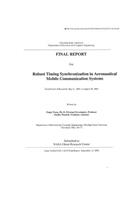
Robust Timing Synchronization in Aeronautical Mobile Communication Systems
Series:
This work details a study of robust synchronization schemes suitable for satellite to mobile aeronautical applications. A new scheme, the Modified Sliding Window Synchronizer (MSWS), is devised and compared with existing schemes, including the traditional Early-Late Gate Synchronizer (ELGS), the Gardner Zero-Crossing Detector (GZCD), and the Sliding Window Synchronizer (SWS). Performance of the sy
NaN
VOLUME
English
Paperback

This work details a study of robust synchronization schemes suitable for satellite to mobile aeronautical applications. A new scheme, the Modified Sliding Window Synchronizer (MSWS), is devised and compared with existing schemes, including the traditional Early-Late Gate Synchronizer (ELGS), the Gardner Zero-Crossing Detector (GZCD), and the Sliding Window Synchronizer (SWS). Performance of the synchronization schemes is evaluated by a set of metrics that indicate performance in digital communications systems. The metrics are convergence time, mean square phase error (or root mean-square phase error), lowest SNR for locking, initial frequency offset performance, midstream frequency offset performance, and system complexity. The performance of the synchronizers is evaluated by means of Matlab simulation models. A simulation platform is devised to model the satellite to mobile aeronautical channel, consisting of a Quadrature Phase Shift Keying modulator, an additive white Gaussian noise channel, and a demodulator front end. Simulation results show that the MSWS provides the most robust performance at the cost of system complexity. The GZCD provides a good tradeoff between robustness and system complexity for communication systems that require high symbol rates or low overall system costs. The ELGS has a high system complexity despite its average performance. Overall, the SWS, originally designed for multi-carrier systems, performs very poorly in single-carrier communications systems. Table 5.1 in Section 5 provides a ranking of each of the synchronization schemes in terms of the metrics set forth in Section 4.1. Details of comparison are given in Section 5. Based on the results presented in Table 5, it is safe to say that the most robust synchronization scheme examined in this work is the high-sample-rate Modified Sliding Window Synchronizer. A close second is its low-sample-rate cousin. The tradeoff between complexity and lowest mean-square phase error determines the...
Price Comparison [India]
In This Series
Bestseller Manga
Trending NEWS




















